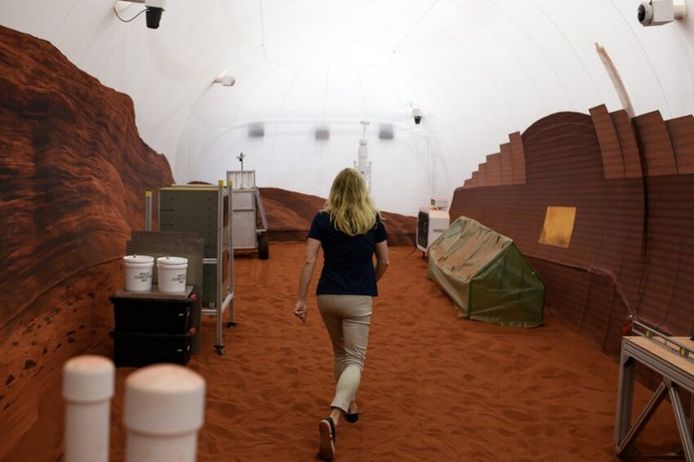The United States space agency NASA has unveiled the 160 m² 3D-printed space in Texas where several groups of people will prepare for the "real-life challenges" of future missions to Mars.
NASA presented the habitat inside a hangar at the Johnson Space Center in Houston, Texas, where four volunteers will begin a year-long "Mars mission" in the ground-based simulation this summer, helping NASA prepare for human exploration of Mars and understanding what life will be like on the Red Planet.
“This is critical for testing solutions to meet the complex needs of living on the Martian surface,” said Grace Douglas, lead scientist for NASA’s Advanced Food Technology research effort.
Visualisation of the Mars Dune Alpha on Mars. Credits: ICON
The first "mission" is scheduled to begin in June when the volunteer crew, who are not astronauts, enters the 3D-printed habitat. It is one of three expected to take place. "Simulations on Earth will help us understand and counter the physical and mental challenges astronauts will face before they go," Douglas added.
'Marswalks' environmental stressors
During the simulation, four crew members will live and work in the 3D-printed module printed by ICON, which includes two bathrooms, a vertical farm to grow salad, a room dedicated to medical care, an area for relaxing and several workstations.
Here, they will carry out different types of mission activities, including simulated spacewalks or "Marswalks," robotic operations, habitat maintenance, personal hygiene, exercise, and crop growth.

NASA’s simulated Mars habitat includes a sandbox with red sand to simulate the Martian landscape. Credit: NASA
The habitat will also simulate the challenges of a mission on Mars, including resource limitations, equipment failure, communication delays, and other environmental stressors.
These so-called "Crew Health and Performance Exploration Analogs" (CHAPEA) aim to help NASA develop methods and technologies to prevent and resolve potential problems on future human spaceflight missions and to better understand what resources need to be provided.
"This is crucial given the very strict weight limits during missions," Douglas explained.
NASA is in the early stages of preparation for a mission to Mars, but the journey – which will take several years – will not take place until the end of the next decade. It is currently focussing most of its work on the upcoming Artemis missions, which aim to return humans to the Moon for the first time in half a century.

